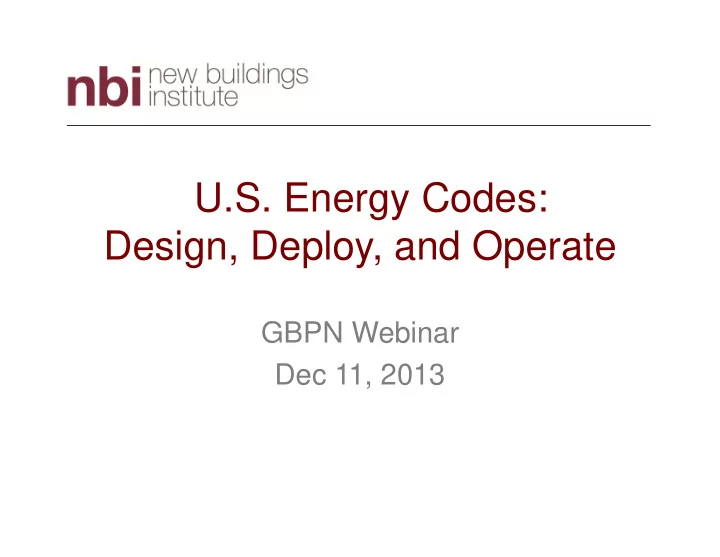

U.S. Energy Codes: Design, Deploy, and Operate GBPN Webinar Dec 11, 2013
New Buildings Institute
Design – Operate - Deploy Drivers to Performance Codes • Design - Reductions to 2030 and Zero Net Energy • Operate – Buildings delivering actual energy savings • Deploy - Adoptions in jurisdictions nationwide and compliance rates to 90%
Model Codes ‐ Design 90.1 ‐ 2010 (IECC 2012)
Range of Outcome 90.1 ‐ 2010 (IECC 2012)
Variability at lower EUI? 3.0 LEEDlevel Certified 2.5 Silver Gold UI (Adj2) Platinum 2.0 Actual / Design E 1.5 1.0 1 0.5 0.0 0 20 40 60 80 100 120 140 Design EUI (Adj2) 6
ZNE Retrofit Example in Portland Oregon - before and after
Plug loads to 2030 Figure 3: Change in Energy Use by System Source: Graph created by Ecova with data from EIA 2008 Annual Energy Outlook
Components of energy outcomes 1 Tenant Behavior Operating Energy Use Characteristics Design Components 0 2000 2010 2020 2030
Energy Codes – Operate TARGETS and ENFORCEMENT The 2 B I G Challenges
Setting Targets? Better Nat. avg. Office EUI (CBECS) Portfolio Mgr. EUI The Basis for Zero Best practice Case Study: The Net Energy (ZNE) existing building Beardmore EUI (ZNE…) Policy zEPI ‐ Based on AEC / Charles Eley’s Beyond Percent Savings
Range of Outcome 90.1 ‐ 2010 (IECC 2012)
Building Energy Disclosure
The Red Line for Energy Codes Design, Build, Commission………. CERTIFICATE OF OCCUPANCY Occupancy
Enforcement Mechanisms • Conditional Occupancy – IgCC (proposed) • Performance/Surety Bond - Seattle • Tax or Utility Rate Structures • Licensing - Boulder • Public Pillory/Accolades • Periodic RetroCx – New York City • Litigation R
Boulder CO SmartRegs The Case for Performance Standards The City of Boulder’s Climate Action Plan calls for greenhouse gas emissions reductions across, Boulder residents overwhelmingly approved a Climate Action Tax to fund Climate Action Plan efforts. For more than a decade the city has been incrementally strengthening minimum energy efficiency standards for residential new construction and remodels as well as for commercial construction and renovation. Despite these efforts, Boulder has not been on track to meet its 2012 Climate Action Plan goals , and the city determined that it needed additional policy tools to encourage market innovation in improving existing residential building energy performance. Rental units make up more than 50 percent of Boulder’s dwellings and thus offered a logical next opportunity for energy savings. The city designed its “SmartRegs” ordinances to deliver multiple public and private benefits including improved building quality and marketability ; safer, healthier, and more comfortable housing; lower energy bills for occupants; and reduced greenhouse gas emissions .
Boulder CO SmartRegs SUCCESS • One year after the regulations went into effect, the city had handily exceeded its first ‐ year goals of 1,000 units inspected and 500 units achieving compliance. • Some property owners are voluntarily choosing to upgrade beyond the minimum requirements. • Given its broad support and successful early rollout, SmartRegs shows promise for overcoming transaction costs and reducing barriers to energy efficiency gains in the residential rental sector.
Energy Code – Deploy (Adoptions)
Energy Code – Deploy (Compliance) 90% Compliance Pilot Studies US Department of Energy, Final Report June 2013 BARRIERS: The top barriers to compliance continue to be: 1. Lack of training 2. Lack of resources 3. Lack of compliance information on plan submissions
RE 188 in the 2015 IECC • RE ‐ 188 would allow homes to Target ERI by Climate comply by achieving a target ERI Zone score AND Climate Zones 1 ‐ 2: 52 • Meeting the code’s mandatory Climate Zone 3: 51 measures, hot water pipe Climate Zone 4: 54 insulation requirements, and prescriptive envelope Climate Zone 5: 55 requirements from the 2009 IECC. Climate Zones 6: 54 Climate Zones 7 ‐ 8: 53
Goals of the Concept • Provide a platform to move the code toward net ‐ zero • Increase compliance for residential energy codes. – Develop format that would encourage third party inspection – Reduce jurisdiction manpower requirements to review energy
Design - Operate - Deploy • Design – Net zero: consumption = production (i.e performance) • Operate – “ Performance” is the only option • Deploy – “Performance” is easier to enforce but challenged by targets & enforcement
U.S. Congress
U.S. Energy Codes: Design, Deploy, and Operate GBPN Webinar Dec 11, 2013 jim@newbuildings.org
Recommend
More recommend